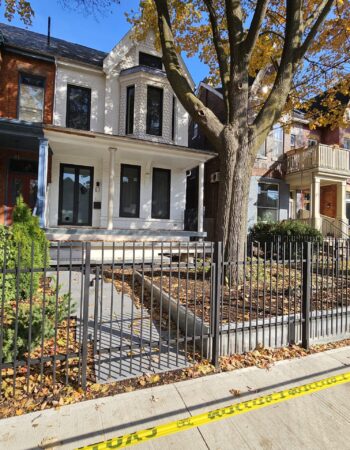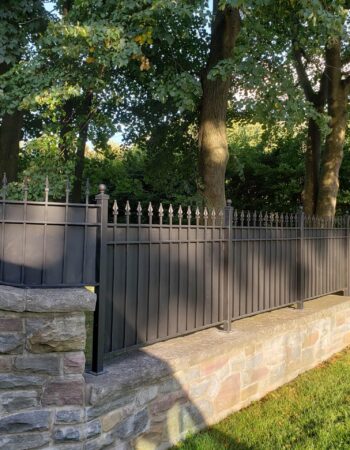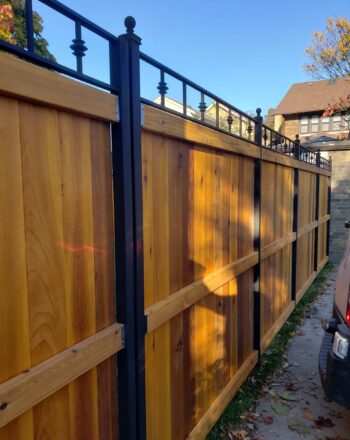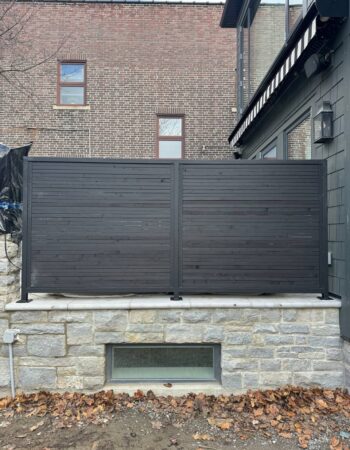Last Updated on November 21, 2024 by chanuka chanuka.23e2
Updated: November 21, 2024

If you’re a homeowner in Toronto planning to install a fence for added security, privacy, or simply to enhance your property’s curb appeal, it’s important to familiarize yourself with the city’s fence code regulations. Understanding the height restrictions set by the Toronto Fence By-law is crucial to ensure compliance and avoid potential fines or issues down the line. In this informative guide, we’ll navigate the ins and outs of Toronto’s fence height regulations and provide valuable insights to help you create your ideal fence while ranking well on Google with optimized content.
Key Takeaways
- Fence Height Varies by Location: Toronto’s Fence By-law specifies different height limits for front, side, and rear yard fences.
- Front Yard Fences Are Limited to 1.2 Meters: Exceptions allow for up to 2 meters if set back from public highways or based on zoning rules.
- Rear Yards Allow Taller Fences: Fences up to 2 meters (6.5 feet) are generally permissible, offering greater privacy.
- Corner Lots Require Special Care: Safety regulations may limit fence placement and height to ensure visibility.
- Professional Help Ensures Compliance: Hiring experts simplifies navigating local by-laws and ensures a smooth installation process.
Determining Maximum Allowable Fence Height:
According to the Toronto Fence By-law, the maximum allowable fence height varies depending on the location within your property. The front yard, side yard, and rear yard each have their own set of regulations. It’s essential to consult the by-law or a professional fence contractor to determine the specific height limitations for your property.
| Item | Description of Fence | Fence on Single or Multiple Residential Property | Fence on Nonresidential Property | Hedge, Shrub, or Other Vegetation that Acts as a Fence |
| 1. | Fence in a front yard; and within 2.4 metres of a lot line abutting a public highway (public highway does not include a public lane) | 1.2 metres | 1.2 metres | 1.2 metres |
| 2. | Fence in a front yard; and not within 2.4 metres of a lot line abutting a public highway (public highway does not include a public lane) | 2.0 metres | 2.0 metres | No maximum |
| 3. | Fence not in a front yard; and within 2.4 metres of a side lot line abutting a public highway (public highway does not include a public lane); and within 2.4 metres of a driveway | 2.0 metres | 2.0 metres | 2.0 metres |
| 4. | Fence not in a front yard; and between 2.4 metres from a side lot line abutting a public highway (public highway does not include a public lane) and the nearest wall of the main building extended to the rear lot line; and within 2.4 metres of a driveway | 2.0 metres | 2.5 metres | No maximum |
| 5. | Fence on an unroofed deck; and not in a front yard; and not within 2.4 metres of a lot line abutting a public highway (public highway does not include a public lane) | 2.0 metres above surface of deck | 2.0 metres above surface of deck | No maximum |
| 6. | Fence not in a front yard that also is not a fence under Items 3, 4 or 5 of this Table; and abutting a multi-residential property, a non-residential property, a public highway or a public walkway | 2.5 metres | 2.5 metres | No maximum |
| 7. | Fence abutting a rapid transit right of way | 2.5 metres | No maximum | No maximum |
| 8. | Fence for a tennis court, a baseball diamond or other recreational facility | 3.0 metres | No maximum | No maximum |
| 9. | Any other fence | 2.0 metres | 2.5 metres | No maximum |
TORONTO MUNICIPAL CODE CHAPTER 447, FENCES 447-5 June 9, 2021 TABLE 1 MAXIMUM HEIGHT OF FENCES
Front Yard Fence Height:
In most residential areas in Toronto, the maximum allowed height for a front yard fence is typically 1.2 meters, or approximately 4 feet. This height restriction can be chiefly attributed to factors such as safety and visibility, ensuring that fences don’t obstruct views for pedestrians and motorists.
However, it’s worth noting that zoning regulations can differ based on specific neighborhoods, leading to exceptions to this rule. One such prominent exception to this height limit applies if your front yard is not situated adjacent to a public highway. In this case, or if the fence is placed at a distance greater than 2.4m from the lot line, you are typically allowed to build your fence up to a maximum height of 2m, or roughly 6.5 feet.
It always pays off to check with your local zoning and planning office to verify any specific requirements or exceptions that may apply to your property, ensuring that your fence installation complies with all the requisite rules and regulations.


Side Yard Fence Height:
For side yard fences, the height limitation is generally consistent with front yard fence regulations, with a maximum height of 1.2 meters (4 feet). It’s important to note that side yard fences must adhere to property line setback requirements, ensuring they are installed within your own property lines.
Rear Yard Fence Height:
Rear yard fences typically have more flexibility in terms of height restrictions. In most cases, the maximum fence height allowed in the rear yard is 2 meters (6.5 feet). However, it’s crucial to verify this with the Toronto Fence By-law or consult a professional to ensure compliance.
Combining Fence Materials to Optimize Height:
To achieve greater height or add decorative elements to your fence while complying with Toronto’s height regulations, consider incorporating lattice panels or ornamental toppers. These additions can enhance the overall aesthetic appeal of your fence while remaining within the allowable height limits.
Considerations for Corner Lots:
Owners of corner lots should pay special attention to fence height regulations due to the potential impact on visibility for drivers and pedestrians. It’s important to ensure that your fence doesn’t obstruct sightlines, which could pose safety hazards. By observing the regulations outlined in the by-law, you can strike a balance between privacy and safety.


Neighborly Considerations:
Before embarking on your fence installation project, it’s good practice to engage in open communication with your neighbors. Keep them informed about your plans and ensure agreement on shared fence boundaries and heights to avoid potential disputes or conflicts down the line.
Seeking Professional Guidance:
Navigating the Toronto Fence By-law and understanding the intricacies of height regulations can be complex. To ensure compliance and a smooth fence installation process, consider consulting with a professional fence contractor with expertise in local by-laws. They can offer valuable insights, guide you through the permit application process if required, and provide recommendations tailored to your property.
Understanding the height regulations outlined by the Toronto Fence By-law is vital when planning your ideal fence. By adhering to these guidelines, you can avoid potential legal issues and ensure harmony with your neighbors. Make sure to consult the by-law or seek guidance from a fence contractor to determine the specific height limitations for your property. By following these regulations and considering creative solutions like lattice panels or ornamental toppers, you can create a visually appealing fence while maintaining compliance. Remember, engaging professionals and being a good neighbor are essential to achieving your dream fence while making your property both safe and aesthetically pleasing.
FAQs
What is the general height limit for fences in Toronto?
Last Updated on November 21, 2024 by chanuka chanuka.23e2
The limit depends on the location: 1.2 meters (4 feet) for front yards and up to 2 meters (6.5 feet) for rear yards.
Can I add decorative elements to my fence?
Last Updated on November 21, 2024 by chanuka chanuka.23e2
Yes, features like lattice panels or toppers are allowed within the overall height limits.
Do I need a permit to build a fence in Toronto?
Last Updated on November 21, 2024 by chanuka chanuka.23e2
Most fences that comply with the by-law do not require permits, but professional confirmation is recommended.
How do regulations differ for corner lots?
Last Updated on November 21, 2024 by chanuka chanuka.23e2
Corner lots must follow additional rules to maintain clear visibility for pedestrians and drivers.
Who can help with fence installation and by-law compliance?
Last Updated on November 21, 2024 by chanuka chanuka.23e2
Professional contractors familiar with Toronto’s Fence By-law can provide expert guidance and installation.

 Chat
Chat 








